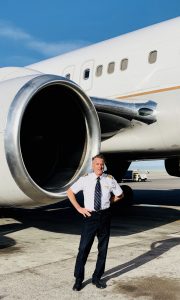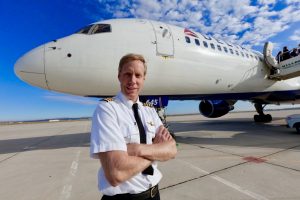Landing the next career opportunity in civilian aviation can be an intimidating mission for pilots transitioning out of the military. For many, this may be their first time establishing a professional profile in networking websites, building a resume, attending career fairs, or asking for letters of recommendation.
According to one Boeing forecast, the worldwide economy will require 800,000 pilots over the next 20 years. An increase in passenger flying and goods transported, along with a mandatory retirement age of 65 contribute to the industry’s growing need. This high “flying” demand for experienced aviators leads many military pilots towards a career path in commercial aviation.
In honor of National Aviation Day (August 19th), this week we reached out for advice from former military Coronado residents who made the successful transition to commercial aviation. Here’s the latest “gouge” to get your civilian career off the ground.

Resident: Jamie Gimber, Coronado High School Class of ’83
Military Background: ROTC at University of San Diego, Commissioned Active Duty in 1988, Naval Aviator SH-60B Helicopter; Joined Naval Reserve in 1996, now retired
Civilian Profession: United Airlines Captain, Boeing 757/767
Pre-flight: Preparing for the Transition I didn’t realize I wanted to fly for the airlines until my second tour. I tried to accumulate as much multi-engine fixed-wing time as possible, including instructor time in the C-12 Huron and SA-227 Metroliner. The only course I attended was the Navy TAP (Transition and Assistance). At the time I took it, it wasn’t too helpful for an aviation career. The big step was obtaining all of my aviation ratings, including ATP (Airline Transport Pilot). I believe that today it is a little more difficult for a Naval Helicopter pilot to get fixed-wing time while still in the military. At a personal financial investment, acquiring outside civilian flying hours will help. Also, many can pursue a job with regional airlines to build fixed-wing time.
Transitioning from military flying to commercial aviation was just a natural progression. I was getting my MBA while still on active duty and decided that riding a desk for the rest of my civilian career was not too enticing, so I chose aviation. The schedules at the airlines are pretty good and offer opportunities for time off and flexibility. There are some drawbacks, however, as the airlines still fly on holidays and birthdays. There are many events one misses out on with this job.
Approaching the Interview The interview process is completely different from when I went through, but many of the key elements of a successful interview still remain. Be prepared. Be professional. Be yourself. Be humble. Have your application, paperwork, and logbook in order. There are numerous online forums with up-to-date information and tools for success regarding the interview process.
De-briefing: Reflection on Military Career I chose SH-60B helicopters in flight school to get back to Coronado, followed by one tour at NAS Point Mugu. In 1996, I joined the Naval Reserve flying the DC-9 for VR-57 at North Island. I didn’t think I would make the Navy a career, but transitioning to the Reserve was a nice way to stay attached to the military and work in the civilian sector. After 20 years of combined service it was time to go.
Flying for an airline and flying in the Reserve is definitely a harder path to take, as they both require a lot of your time. Reserve flying requires more time than “Weekend Warrior” Reservists because you have scheduled detachments and flying qualifications to maintain. However, I highly recommend keeping with the Reserve for the retirement benefits and small pension.
Captain’s Logbook: Civilian Career Perspective I was hired by United at the end of 1997. At the time, it was the airline of choice. Then 9/11 occurred causing a large round of layoffs and pay cuts. Although I was not furloughed, the decrease in relative seniority and pay made for some difficult times. Additionally, the FAA changed the mandatory retirement age from 60 to 65 resulting in no retirements or hiring for many years. Not a great time in aviation history. Placing that in perspective, it took me about 15 years before I could hold captain at the airline. Today we are seeing folks with 3 years seniority holding captain.
We are now experiencing an unprecedented time in commercial aviation. Upgrade times to captain are quick, and our pay scales are now back up and lucrative. There are countless opportunities to fly different aircraft on different routes, from short haul domestic to long haul international flights. There is a looming pilot shortage, so now is a great time to pursue an aviation career.
Tips for Survival: First Year The first year of probation was not too hard. Be on time. Be professional. Don’t miss any trips. For first officers (the position hired into), they need to get along with their captains, becoming chameleon-like by adapting to a captain’s particular style of flying. Now most major airlines today have strict SOPs (Standard Operating Procedures) that if one simply follows, they will be fine.
“On Final” Advice For the military pilot transitioning after their obligated service, it’s important for them to be current—flown at least 100 hours in the prior year. I recommend finding a Reserve job just in case the airlines take a turn for the worse and for the retirement pay. Currently, many Naval Aviators are getting hired after a successful 20-year career. In today’s airline environment, getting hired in your 40s will still provide for a 20-plus commercial career and well worth pursuing. Depending on your personality, flying commercially is definitely not for everyone, but the saying goes “They all come back.” To clarify, many folks who were furloughed or left the airlines voluntarily to work in another part of the civilian sector usually return. So it must be a pretty good gig.

Resident: Art Gutting, Coronado Resident
Military Background: OCS Commissioned Active Duty in 1999; Naval Aviator F/A-18, former Naval Flight Officer S-3B; retiring Fall 2019 (on terminal leave)
Civilian Profession: FedEx First Officer, Airbus 300/310
Pre-flight: Preparing for the Transition Getting out of the military is a big administrative process. It’s not something you want to leave to the last minute when starting your new career or job searching. Because of the amount of prep, I started my transition 14 months out.
Preparation is the key. I personally started networking with my fellow pilots, did resume prep, technical test prep, hired an airline-specific consulting agency, and requested many letters of recommendation. Be ready to spend money on some of these services, including updating your business attire (that Hawaiian shirt you’ve been rockin’ isn’t considered business casual either).
Approaching the Interview Interview prep is out there and I highly recommend it! You don’t want to go into the “interview of your life” cold. During the last six months of your military tour, you should update your application every two weeks and consider attending career fairs to meet some of the hiring team. Only one company called me, but it was my first choice. I was notified two months prior to my availability date.
De-briefing: Reflection on Military Career It’s a bittersweet experience. Naval aviation has been an absolute blast and I loved it to the last day. The end comes quick and the perceived pressure is huge if you have been in the military all of your adult life, like myself. The key is to start early and ask yourself four questions: 1) Where do you want to live? 2) How will this impact the quality of your family life? 3) What quality of work life do you desire? 4) What type of compensation are you looking for?
As for the retirement pay or benefits, those have yet to kick in since I’m still on terminal leave, but understand the new system for the Navy is fully online. I would recommend getting everything done as far out as possible to allow you to focus on the transition and not “drop the pack” in your last tour.
Tips for Survival: From Job Offer to First Year I recently started training, but I love it so far! I would say be humble, get ready to learn, and know that each airline has a particular way of doing things.
The flexibility, time off, and compensation are impossible to beat. With that being said, financial planning in advance is vital during your first year. For some commercial carriers, it may be months before your training date after receiving your job offer. Training salary is often capped and the hourly pay scale during your first year of flying may be significantly lower than what you will earn in your second year and beyond—so hang tight! Many forums and websites can provide answers to these questions that are worth looking into before you begin your transition.
“On Final” Advice I loved the Navy! It gave me so many opportunities to do some unbelievable things. As a retiree, I wouldn’t change anything. But you have to realize that you give up seniority the longer you stay in the service. On the other hand, as soon as you get out, there is no going back to that type of active duty flying.

Resident: Tom Lancaster, Coronado resident
Military Background: AOCS Commissioned 1983, S-3 Naval Aviator, joined Reserve in 1990, retired from Reserve
Civilian Profession: Delta Air Lines 757 Captain
Pre-flight: Preparing for the Transition I was an instructor in the S-3A Replacement Air Group, (RAG) Squadron when I decided to start the transitioning process. Originally, I planned to pursue a MBA, but a few Reserve friends already working for various carriers persuaded me to apply. Their lifestyle and time off of work was very enticing. With that decision made I looked for opportunities to improve my resume for a commercial aviation career. As a RAG instructor, I taught the first Aircrew Coordination Program introduced by the Navy, including two other unique programs to boost my resume. Anything you can do to stand out in a good way is a tremendous help for any applicant.
Approaching the Application Process and Interview Major air carriers are hiring applicants with the expectations that these new hires will be with them until they reach retirement age. They are very selective and looking for applicants that can work well in a crew environment and be excellent company representatives. Take the time to prepare well for the interview. The competition is still very tough with larger commercial companies. Since you will be competing against civilian pilots with thousands of hours getting as much flight time is paramount. However, the airlines do understand that many military pilots are hard pressed to amass an equivalent sum of flight time as civilians, so they definitely take that into consideration. They also appreciate the quality of the training from military pilots with most companies preferring to hire military over civilian. Your flight records need to be meticulous and your attitude inspiring. The job is full of rewarding moments and carries great responsibility. Bottom line, they have to feel you are a good fit as a crewmember and work well with others. I think this is the most important aspect of the interview process.
De-briefing: Reflection on Military Career I also flew in a Reserve squadron and enjoyed that very much. I did find it difficult to have two jobs at the same time. Our fourth child was born the same week our Command Screening Board convened. This prompted my decision to reconsider my investment with Reserve time and go “inactive” to finish my time for retirement. Each individual has different needs and desires for their personal life and those decisions have a way of becoming apparent as you progress through your careers.
Captain’s Logbook: Civilian Career Perspective My career at Delta started as a Flight Engineer on the Boeing 727 progressing to 767 First Officer then Captain. Airlines in the ’90s started their new hires as Flight Engineers followed by advancement to the right and lefts seats. I’ve truly benefited from my decision to pursue an airline career and am fortunate to live close to my Los Angeles domicile with a flexible work schedule. It afforded me the opportunity to be active in raising our four daughters, coaching their sports teams, and working in the school classrooms. Today with the multitude of retirements taking place, a new hire pilot can advance to Captain in a few short years. It’s a great time to get started with any of the carriers.
Tips for Survival: First Year One of the most challenging aspects of the decision to leave the military for commercial aviation will be the financial struggle of getting through the first few years of low pay. The pay scales are tiered with some very disappointing pay rates for the starting years. Planning accordingly and tightening your belts during the lean years can definitely test your resolve. It will get better and the industry is enjoying a prosperous period now—so don’t despair!
“On Final” Advice The airlines are seeking diversity within their workforce and are especially encouraging of women to prepare for careers in the aviation field. For women interested in such a career—the skies are literally the limit. If you’re unsure when the right time to take the leap from military service to major airlines is—the best place to start is by asking yourself what you really want to do for the rest of your career. The bonds you will form through your military careers are tough to replicate once you leave active duty. That being said, the future for new hire pilots within the aviation industry is probably brighter than it has ever been in history.
Readers, do you know a Coronado Aviatrix? For National Aviation History month in November we would like to feature profiles of female pilots residing in Coronado. If you know any civilian or military female pilots who would like to share their story, please email [email protected].





